We kindly inform you that, as long as the subject affiliation of our 300.000+ articles is in progress, you might get unsufficient or no results on your third level or second level search. In this case, please broaden your search criteria.
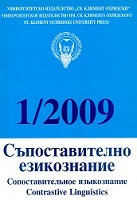
A new approach to the analysis of eighteenth century Bulgarian texts is proposed. They are classified into four types - a strongly classicized, an intermediate, a moderately classicized and a demotic one - which differ in the degree and the character of their classicization on the phonetic, morphological and syntactic level. With all the four written-language styles the vocabulary combines a good deal of the centuries-long tradition (abstract words, names for religious concepts, natural-science and philosophical terms) with innovative lexical items, as it is in present-day Bulgarian, and the spelling is traditional. The Greek moderate Katharevoussa (as a means of making a linguistically modern text look classical-like) is the typological model for the moderately classicized eighteenth century Bulgarian written style, as the Greek Dhimotiki is for the demotic one. Two varieties of the classical written language provide linguistic samples for the eighteenth century Bulgarian scribe: the South Slavic (Serbo-Bulgarian) bezjusov one (without letters for the Old Bulgarian nasal vowels) and the East Slavic Church Slavonic one. The language of Paisij Hilendarski is of the intermediate strongly-to-moderately classicized type with a mixed traditional Serbo-Bulgarian and East Slavic phonetics and orthography and does not contain dialectal-vernacular phonetic features as some specialists in the history of Written Bulgarian claim.
More...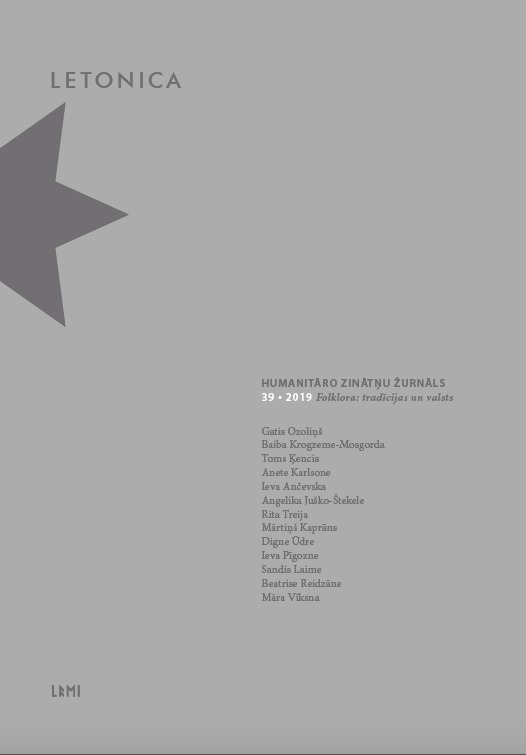
In 2014, the Archives of Latvian Folklore started developing its digital archive, which, among other things, offers an opportunity to develop new digital tools and resources for indexing folk narratives. Since the 1850s, a sizeable legend corpus has been documented in the territory of Latvia, and extensive collections have been published. While initiating the development of a digital index of legends, this article aims to consider the most comprehensive collections and publications as of today, as well to characterise the applied systems of classification and indexes. It was in the 1850s and 1860s when the first calls to write down folktales and legends were published in the press, and when the Latvian folk narratives started attracting wider interest of both Baltic German scholars and emerging Latvian intellectuals. In 1887, Fricis Brīvzemnieks published the first academic collection of folktales and legends, which included 186 texts. In this collection, the folktales and legends were classified by the genre and subject. The majority of the folktales (1863 texts) and legends (3254 texts) collected in the 19th century was published in the seven-volume edition “Latvian Legends and Folktales” (1891–1903, 2001) edited by Anss Lerhis-Puškaitis. It was the largest collection of Latvian folklore and one of the most sizeable publications of folk narratives in Europe at that time. In the early 1890s, the popularity of British anthropologist Edward Tylor’s theory of animism was growing. As no particular classification system of legends was approbated in international research circles, Lerhis-Puškaitis developed a unique system of legend classification, which was based on the theory of animism to arrange the voluminous text corpus; however, it fell under criticism in the early 20th century. The largest current publication of Latvian folk narratives (4309 folktales and 3586 legends), “Latvian Folktales and Legends” (1925–1937), was prepared for publishing by Prof. Pēteris Šmits. As for systematisation of folktales, Šmits implemented a state-of-art classification system introduced by Antti Aarne based on the historic-geographic method. Unlike folktales, researchers of legends did not have any internationally applied catalogue of legend types available at the time. Šmits classified the legends into four sections: 1) etiological legends, 2) mythological legends, 3) place legends, and 4) historical legends. The Archives of Latvian Folklore (ALF) was established in 1924 with its main task to collect and archive Latvian folklore, including legends. Along with intense activities of folklore collecting, the ALF was publishing and studying the collected materials, yet no developments toward a legend index were initiated. Having recognised legends as a significant genre for the Soviet ideology, a catalogue was initiated in the 1950s by Herta Vaita (the card index of legends). In the early 1960s Alma Ancelāne engaged in the research and classification of legends, and this also concurred with the discussion activated by the International Society for Folk Narrative Research regarding the development of an international catalogue of legends, which indirectly affected Ancelāne’s work. The card index of legends, which was completed after almost 30 years, covers nearly all of the material held in the ALF, some 57,000 texts. The material was primarily divided into etiological, mythological, and historical legends, whereas a more detailed subdivision was created grouping the legends into several sub-levels based on motifs, types, and occasionally by the themes included therein. Although Ancelāne’s card index greatly helps in orientating oneself to the collection of legends held in the ALF, it can hardly be considered as a fully completed index of motifs or types of Latvian legends. After WWII, Latvian émigrés also contributed to the classification of legends. In 1981, Lena Neuland published “Motif-Index of Latvian Folktales and Legends”, which followed the pattern of “Motif-Index of Folk Literature” by Stith Thompson using both Thompson’s names and numbers of the motifs. In 2014, the digital archive of ALF, garamantas.lv, began providing options for the development of new digital tools and resources in the research of folk narratives. Much has been accomplished in the field of legend research by now, yet there is still much to be done. A sizeable number of legends have been collected, and a large portion of them has been published, but this material has not been compiled in a single data corpus. A motif-index of Latvian legends has been developed which is accessible to the international community of legend researchers, but the material it covers equals less than 5% of the entire text corpus. Likewise, a type-index of Latvian legends should also be developed. In addition, an equally wide selection of Latvian legends should be published in English. By developing a mapping tool, the digital archive would allow for the visualization of the geographical distribution of each motif and type. There are plenty of plans and intents to implement. The first impressions gained from an implementation of those will be addressed in a separate article.
More...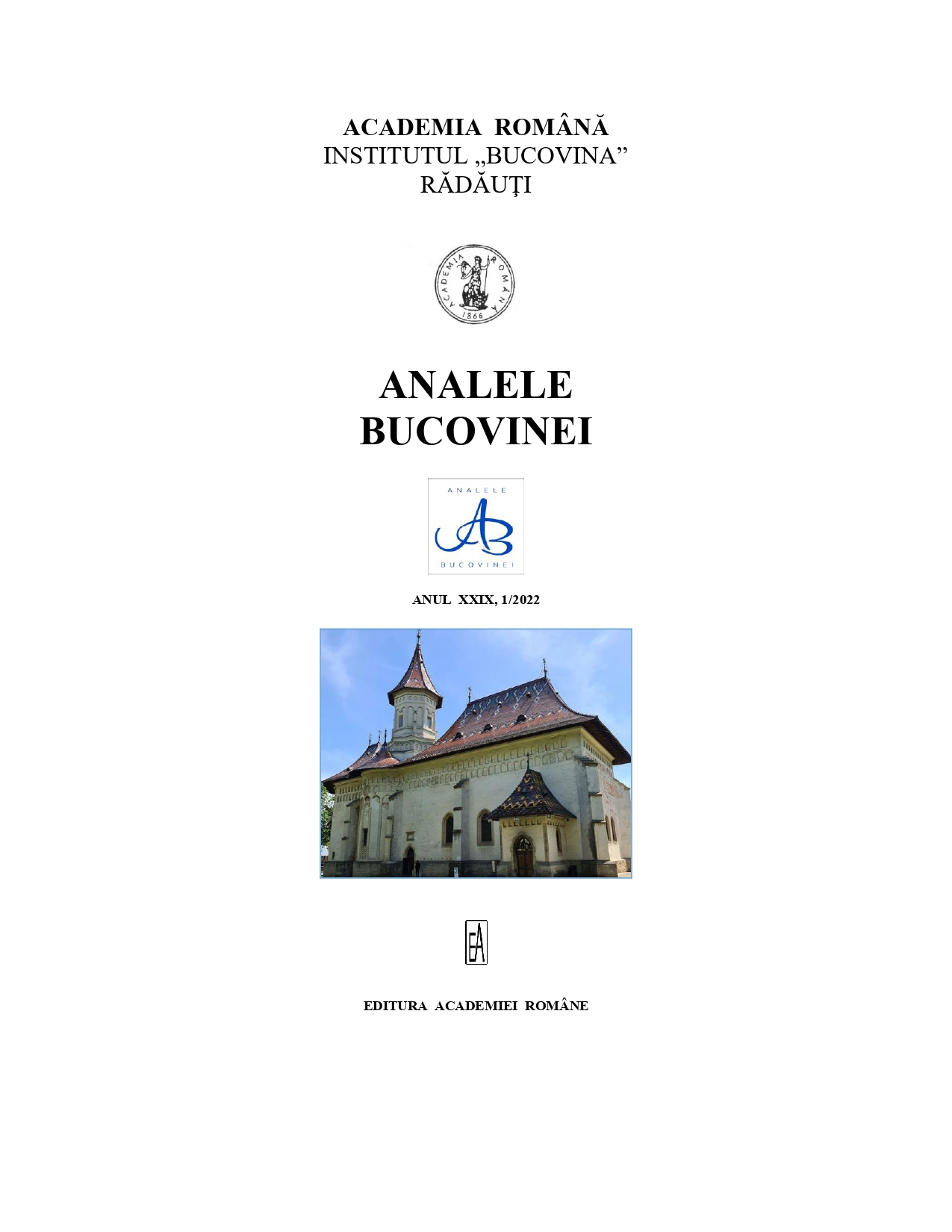
The first part of the article presents some of the legislative measures regarding the construction of buildings in Bukovina, issued during 1783–1863. These relate to: “fire regulation”, “regulation and widening of streets and markets and the use of construction materials only”, the construction of adjacent buildings, garbage dump and road construction distance, use of “solid construction materials”, use of bare bricks, construction of holes and use of zinc to cover private buildings, and so on. Two laws were drafted on “the offices called to exercise the construction policy and their operation”. In the second part are described the typologies of traditional construction in Bukovina, a region where the woodworking craftsmanship has taken shape since archaic times. Over the years, techniques have been developed for a comfortable living, the solutions found for joining beams or making roofs (with shingles of different sizes) with two or four sloping sides being some of the elements of authenticity of the traditional Bukovinian architecture. From a single-room dwelling with a porch house, the traditional wooden house evolved to a “room-passage-room” type of house, with a veranda, an arbour in front of the house and a pantry on the back. The shape, materials, dimensions and construction technique of the doors and windows, the use of natural building materials for the foundation of the house (cut and shaped stone blocks, without any mortar to bind them) complete the harmonious appearance of the traditional Bukovinian house. The decorations of the houses (often fretwork patterns like rosettes, squares, rhombuses, rectangles, moose, ropes, birds, “trees of life”) are characterized by sobriety and include symbols specific to the spirituality of the place. The roofs also have decorative elements like the so-called “beetles”, or fumigants and pins on the top. Some of the fences, made of beech or plank, have roofs with two slops, with decorative elements (carving or fretwork) on pillars and gates. Regarding the household annexes (stable with barn, cellar or pantry,summer kitchen) – these are positioned around the house and are built of the same materials as the house.
More...
Review of: Bogdan Petru Niculică, Ştefăniţa-Mihaela Ungureanu, Josef von Gutter, cel dintâi arheolog al Bucovinei şi scrisorile sale către istoricul Franz A. Wickenhauser, cuvânt înainte conf. univ. dr. Mircea Ignat, Suceava, Editura Karl A. Romstorfer, 2019, 242 p. Mihai Iacobescu, Însemnări despre oameni și cărți, Iași, Editura Junimea, 2020, 242 p. Marian Olaru (coord.), Ștefănița-Mihaela Ungureanu, Cristian Alexandru Boghian, Case tradiționale din Bucovina, Editura Universității „Ștefan cel Mare”, Suceava, 2020, 149 p. + 5 p. Mugur Andronic, Fortificațiile Bucovinei de-a lungul timpului. Bukovina fortifications over time, seria „Pagini din istoria și cultura Bucovinei”, XIX, Societatea Culturală Ștefan cel Mare – Bucovina), Suceava f.e., 2021, 184 p. + 44 planșe. «Glasul Bucovinei». Revistă trimestrială de istorie şi cultură”, Cernăuţi – Bucureşti, anul XXVI, nr. 1–2 (105–106), 2020, 223 p. „«Scriptum». Publicație trimestrială a Bibliotecii Bucovinei «I. G. Sbiera»”, Suceava, anul XXVII, nr. 1–2, 2021, 40 p.; nr. 3–4, 2021, 40 p.
More...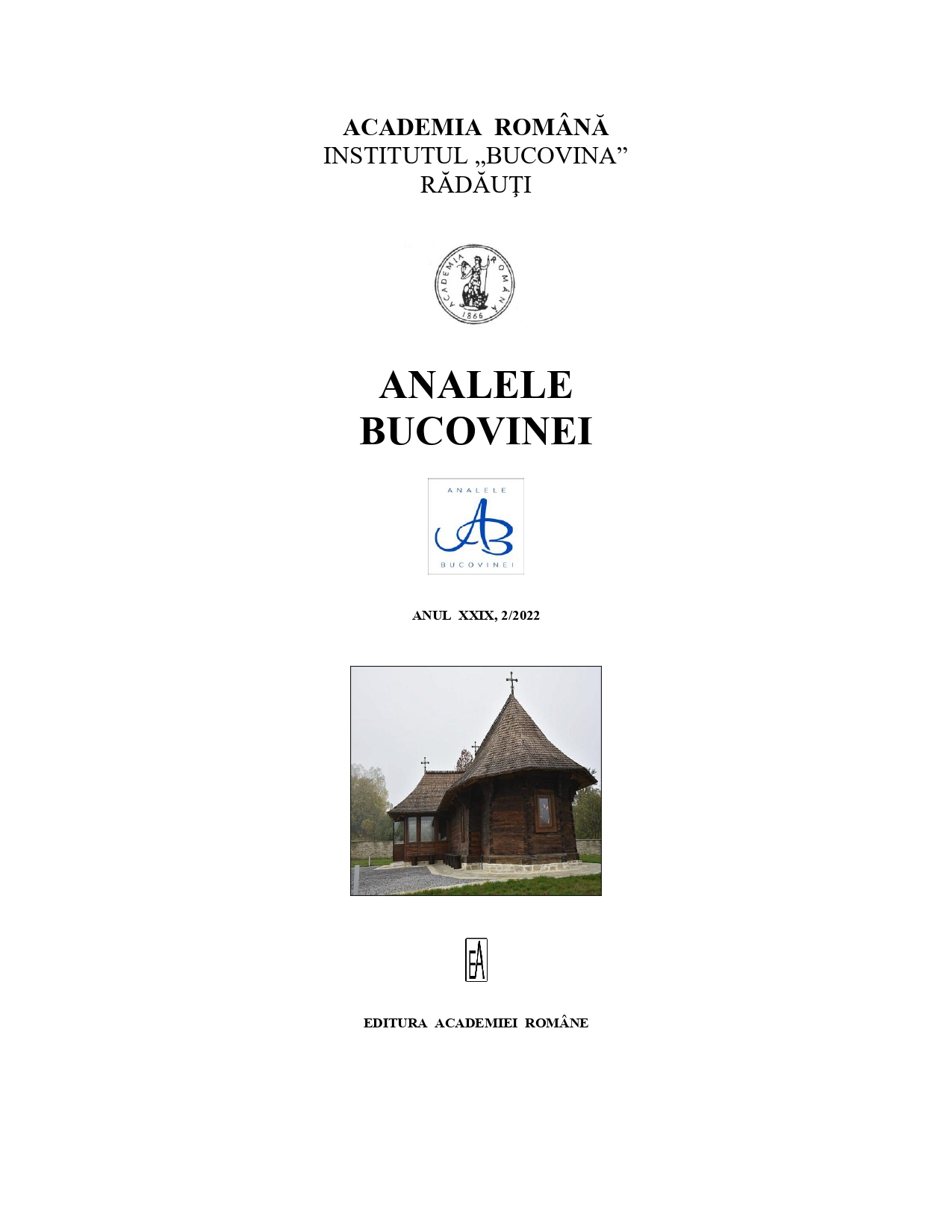
Review of: Die Habsburgermonarchie 1848–1918. coord. Rudolf Gräf, Editura Polirom în 2020, 2021 și 2022. Mitropolitul Vladimir de Repta și lumea prin care a trecut,. pr. Dumitru Valenciuc, pr. dr. Ioan-Paul Valenciuc, (Suceava, Editura Arhiepiscopiei Sucevei și Rădăuților, 2018, 346 p + anexe) 2022. Familia Cuparencu din satul Călinești. ținutul Suceava, studiu genealogic, Preotul Cezar Onesim, anul 2020, la Editura Miseno din Șcheia, județul Suceava, lucrarea (Șcheia – Suceava, Editura Miseno, 2020, 395 p. + 1 p.). Cântece propriu-zise din Moldova. Silvia Ciubotaru și Ion H. Ciubotaru La Editura Universității „Alexandru Ioan Cuza” din Iași, 2021, coord. prof. univ. dr. Ion H. Ciubotaru, (458 pag.) „Caiete de la Volovăț” (Revistă de teologie și cultură a Parohiei Volovăț, anul I, nr. 1, 2021 și nr. 2, 2021). Colegiul redacțional: pr. Dumitru Valenciuc, pr. prof. dr. Ioan Paul Valenciuc, protos. dr. Mihail Nagy, prof. Dorina Diaconescu, prof. Lucica Antonovici.
More...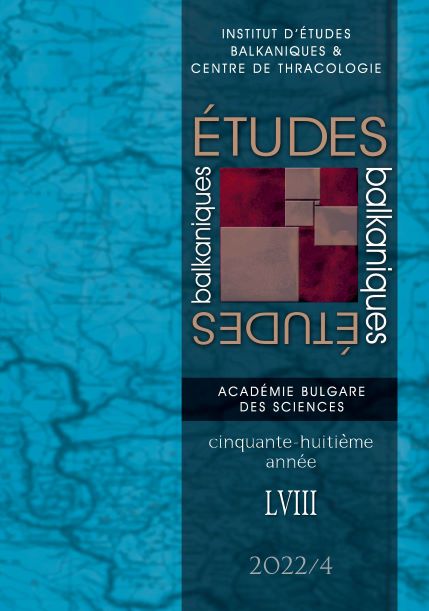
The present article is focused on separate aspects of the political skirmish between two prominent representatives of the Bulgarian and Greek communities – Nayden Gerov (1823 – 1900) and Georgios Tsoukalas / Γεώργιος Τσουκαλάς (1804 – 1872). At the beginning of the 50s of the XIX century, the establishment of the Bulgarian school in Plovdiv gave rise to one of the first public disputes between the two ideologists in the context of the development of nationalisms. The article depicts some moments from the Bulgarian-Greek arguments on the pages of periodicals – ‘Tsarigradski vestnik’ and ‘Bosphorus Telegraph’. In a word duel, the two intellectuals resort to the specific pejorative rhetoric of subversion and slander. This strategic rhetoric is characterized by an intensified ideological load and lavish figurative argumentation, often accompanied by expressive ideologies, with a multitude of offensive words, provocations and critical comments. Through the use of such rhetorical techniques, the prominent socio-political figures aim not simply at the personal undermining of their opponent, but above all, at defending their own ideology and contestation of the alternative opinion. In the confrontation between the text strategies (some of them deliberately anonymous, allowing the identification of the people with the text) of N. Gerov and G. Tsoukalas, the two political programs are revealed in their contrast and convergence to the own / foreign ideological code.
More...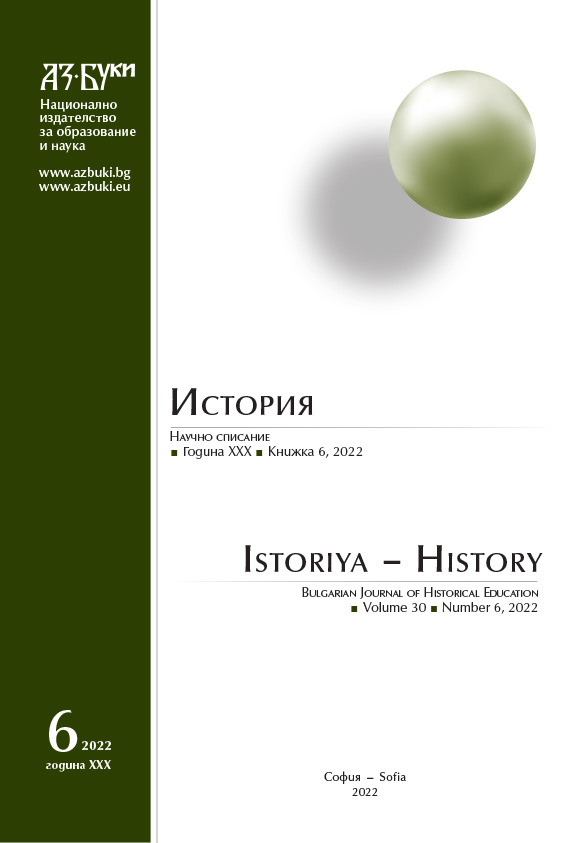



In this paper we explore the long-term developments of consumer prices in Bulgaria for the period 1750–2020. The discussion draws on a component-based index of consumer prices constructed by the authors. We consider both nominal price-level time series and real prices of selected essentials (bread, meat, sugar, tobacco, alcohol, and construction goods used by households). For the reviewed period, we identify two major inflationary episodes, namely the two World Wars and the interwar period, and the period of post-communist transition. For the former, we compute an increase of the price level of about 46 times. For the latter, we arrive at a mind-blowing analogical result of over 3800 times. A curious finding concerns the communist period. Contrary to popular beliefs established through a massive propaganda of no-inflation socialist economies, we discover an overall increase of the price level for that period of nearly 4 times. Real prices of individual commodities are calculated by deflating nominal figures by the value of the corresponding base consumer price index. The inspection of their dynamics leads to uncovering hidden insight related to the developments of specific markets. Also, it allows to assess more clearly the similarities and differences of real price evolutions over different political regimes. For example, we find that the real price of bread in the times of communist rule did not contrast markedly with its levels in preceding and succeeding periods. Another example points to the conclusion that in the years of EU membership, the real prices of most commodities that we consider follow a path of decline. This suggests that statements on the economic developments in those years which rely heavily on the popular perception of lower affordability should at least be taken with a grain of salt. The availability of our results could facilitate further explorations into the nature and specifics of the economic and social development of Bulgaria over a long period of time.
More...
The article presents Bulgarian market main foreign trade relations in the period of its foundation, i.e. in the 1850s, 1860s and 1870s. The Bulgarian lands foreign trade during this period is presented as an attempt to answer the question which foreign markets have the strongest influence on the processes in the Bulgarian economic space. The research paper is based on primary archival sources from the French Diplomatic Archives (Archives diplomatiques du Ministère des Affaires étrangères), mainly on reports of French consuls in Plovdiv (Philippopolis), Varna, Kustendje (Constanța) and Tultcha, on the data of archival sources and published research results concerning large Bulgarian companies such as “Evlogiy and Hristo Georgievi”, “Hristo P. Tapchileshtov” and others. The main conclusion of this article is that the foreign trade dilemmas facing the Bulgarian market in the third quarter of the 19th century in the alternative between the East and the West were decisively resolved in favour of the West, in favour of Western and Central Europe. Cereals, silkworm cocoons, rose oil, wool and tobacco are exported from the Bulgarian lands to the European markets while colonial and manufactured goods are imported. Another important conclusion is necessary – since its consolidation in the middle and in the third quarter of the 19th century, the Bulgarian national market is closely connected to the free European market and this is a good reason for the Bulgarians to adjust to the free market behaviour – a behaviour that’s not tied with political interventions or ideological interventions.
More...
During the Bulgarian National Revival period there were settlements across Ottoman Bulgaria where a number of public figures, revolutionaries and businessmen were born and raised. The reasons for the appearance of such alert people are numerous and interrelated. Among the factors can be mentioned the specific natural and climatic conditions, the favourable geographical location of such settlements; the awake public atmosphere in them; intensive development of craft production and trade; availability of near and distant markets; the institutional changes in the Ottoman Empire; etc. On the other hand, it seems that very important are social, family and human capital– assets that are purposefully created and maintained in such settlements. The purpose of the current article is to shed light on regions and settlements where rapid economic and social development was not available in the 18th and 19th centuries. The main question I will try to give an answer is why an entrepreneurial class did not emerge in some regions and settlements during the Bulgarian National Revival period. There are several factors that contributed to the fact that a Bulgarian entrepreneurial class did not appear in regions such as the Black Sea area, the western and south-eastern Bulgarian lands (with some exceptions), etc. The factors are as follows: the privileged status of the local population in the 16th and the 17th centuries did not have a positive impact on the socio-economic processes later; the low influence of the Tanzimat reforms; the absence of more active market relations; the slower incorporation of some of the mentioned regions into the emerging national market; the lack of a larger urban centre in the region of Gorna Struma, which would stimulate more active economic processes and connections in the region and beyond it; the presence of competing ethno-confessional groups (Greeks, Jews) that have entrepreneurial experience and contacts; the specific economic conditions that helps to cultivate archaic mentality in some regions; the complete or partial absence of social and family capital; the lack of human capital, as well as institutions (such as secular schools, etc.) that could contribute to its creation and maintenance; the lack of Greek cultural influence, which contributed to the formation of people with a particular economic thinking and behaviour in other regions. There are regions and settlements across Ottoman Bulgaria that did not impress with their dynamic socio-economic and public development during the National Revival period. Their historical destiny deserves to be researched because it could give us a more realistic idea of the socio-economic transformations that took place in the 18th and especially during the 19th century.
More...
The restored in 1879 modern Bulgarian state found itself in a difficult economic situation. With its economic backwardness, the political parties in the country were persistently looking for models who could allow them to accelerate and catch up with the other European countries. One of the ideas was to use the cooperative as a tool to catch up with the century's lag. However, the situation in the economic sector was such that practical actions were mainly in the area of “Raiffeisen cash registers” and "popular banks", while other types of cooperatives were practically invisible in real economic exchange. In their documents, all organizations gradually accepted the need for a policy of "patronage", which must be carried out with the mechanisms of state policy, especially through the financial sector and ensuring access to cheap credit from the cooperators. Some parties, especially those from the leftist and populist sector, accepted that the cooperative idea can be useful only with direct political intervention in the sector and even through organizational connection between parties and active cooperatives. This early model of authoritarian impulses was extremely persistent in Bulgarian politics and survived even the entire twentieth century. This leads to a distortion of economic relations and a steady increase in state intervention and control over cooperative networks.
More...
Reviews of: Kirjarahva pildiraamat. Fotosid aastatest 2001–2009. Pildistanud Alar Madisson, koostanud Alar Madisson, Piret Noorhani, Vilve Asmer. Tartu: Eesti Kirjandusmuuseum, Kunst, 2009. [127] lk Kirjarahva teine pildiraamat. Fotosid aastatest 2010–2013. Pildistanud Alar Madisson, koostanud Alar Madisson, Piret Noorhani, Vilve Asmer. Tartu: Eesti Kirjandusmuuseum, 2013. [123] lk. Lev Võgotski. Mõtlemine ja kõne. Psühholoogilised uurimused. Tõlkinud Peeter Tulviste. (Avatud Eesti Raamat.) Tartu: Ilmamaa, 2014. 509 lk. Leo Tolstoi. Mis on kunst? Tõlkinud Andri Ksenofontov. (Avatud Eesti Raamat.) Tartu: Ilmamaa, 2014. 314 lk. Eesti perioodikas ilmunud järjejuttude bibliograafia 1918–1944. Koostaja Kalev Sikk. Väljaandja: Lembit Sikk Pärna talu, 2014. 258 lk + Lisad: Anderomaanid, 6 lk; Errata, 1 lk. Kas sa Tammsaaret oled lugenud? Kirjanduslik eluloovestlus Helga Nõuga. Koostaja Rutt Hinrikus. Tartu: Eesti Kirjandusmuuseum, Eesti Kultuurilooline Arhiiv, 2014. 144 lk. Helga Nõu. Valetaja. Mälestused, tõeotsimised. Tallinn: Eesti Ajalehed, 2011. 280 lk. Martin Klöker. Tallinna kirjanduselu 17. sajandi esimesel poolel (1600-1657). Haridusinstitutsioonid ja juhuluuletamine. Tõlkinud ja eessõna Kristi Viiding. Tallinn: Teaduste Akadeemia Kirjastus, 2014. 679 lk.
More...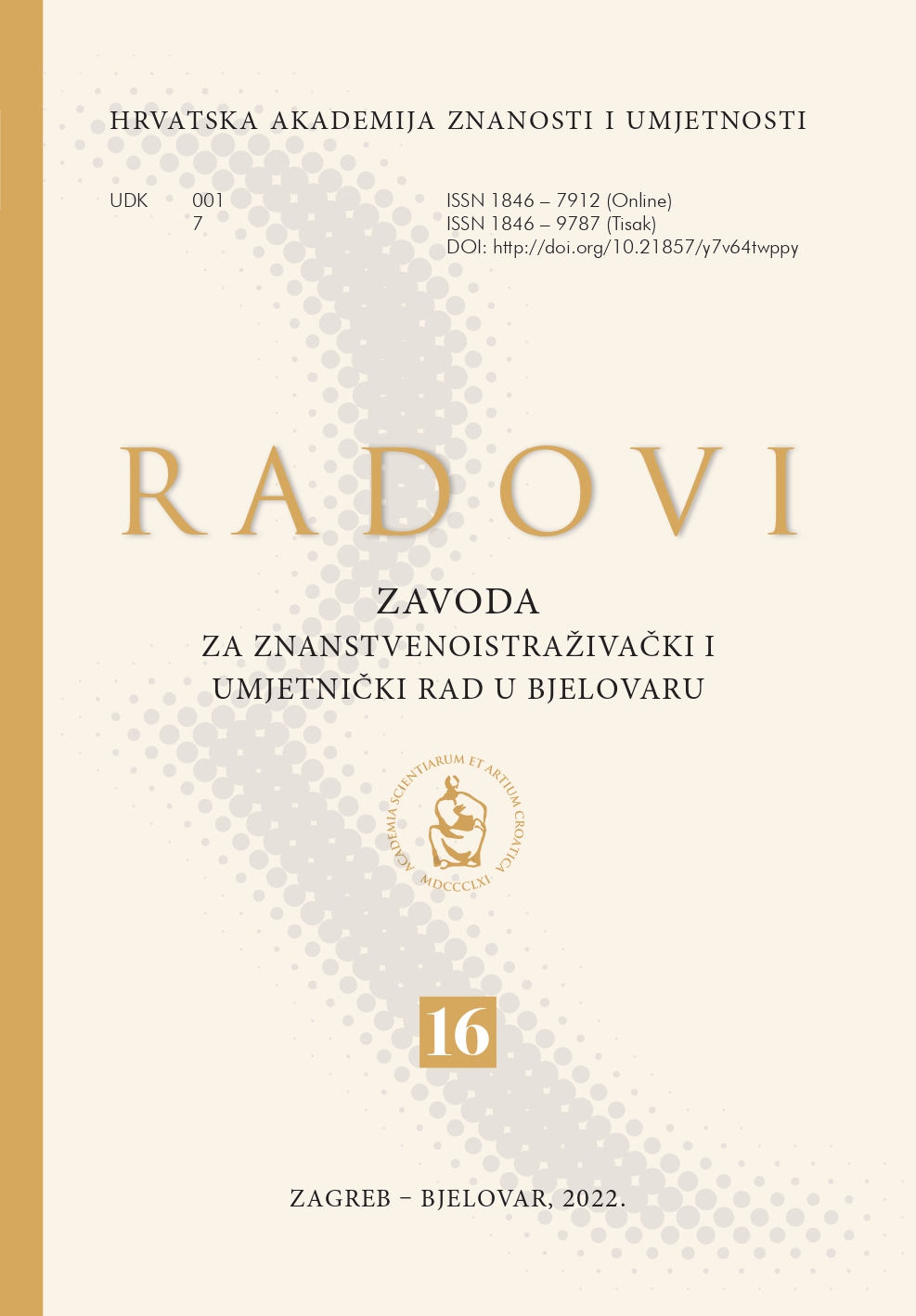
The subject matter is Maria Theresa's policy oriented towards health reforms and positive demography across the Danube Monarchy, which included Bjelovar, a city that Empress Maria Theresa had built in the very centre of the Varaždin Generalate in 1756. This policy consisted of the legalization of medical experts’ education, and the establishment of hospitals and xenodochia based on legal acts covering public health issues, and numerous community regulations. These documents were the key fundament of the later legal health regulations. Before the founding of the city of Bjelovar, there existed no organized or professional healthcare. However, after the founding of the city, legal health regulations were implemented in all components. The first hospital in the city, which still operates today, was established; company sanitary stations with surgeons and company midwives were formed across the Generalate; the first pharmacies were opened; xenodochia (lazarettos) were established in the outskirts of the city as quarantines of a kind; many educated health workers of regulated professions were active in the city and its surroundings: medical doctors (doctors of medicine), junior and senior surgeons, pharmacists, midwives, medical assistants, and nurses. The geographical position of the Varaždin Generalate and Bjelovar, far from active battlefields and the Habsburg-Ottoman border, ensured – thanks to the implementation of regulations covering public health issues – safer public health and the development of healthcare and medicine. The centralized approach of the Viennese court in the second half of the 18th century exercised influence in this respect.
More...
Numerous reforms and breakthroughs, which were truly felt in the coming centuries, marked Maria Theresa's rule. The Cordon Sanitaire, same as Bjelovar, became – thanks to numerous reforms – better organized after her coming to the throne in 1740. The basis for the most prominent among these reforms was the 1770 General Healthcare Book of Rules (Opći zdravstveni pravilnik). Bjelovar was founded as one of the responses to the reorganization of the Military Border, whereas the Cordon Sanitaire was initially established as response to repeated occurrences of the plague in the Habsburg territory, since this situation needed a solution. Unlike Bjelovar, the Cordon Sanitaire ceased to exist after the demilitarization of the Military Border. Nevertheless, its existence and development, same as Bjelovar's, remains one of the symbols of the reorganization of the Military Border and the 18th century in general.
More...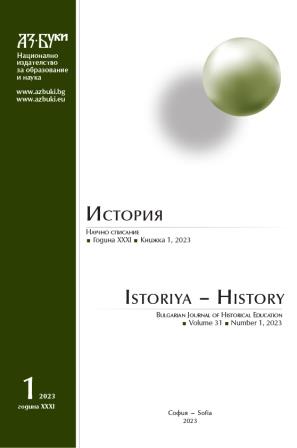
The article published a letter from the Metropolitan of the Diocese of Nisava Antim I, dated August 26, 1854, which refers to the Samokov painter Kostadin Petrovich Valoiv. The content of the letter allows to formulate the hypothesis that the artist worked in the interior decoration of the church “St. Petka” in the town of Trun, probably in 1853 or in the first half of 1854. The document provides information that K. Valiov resided in the town of Pirot in 1854, supplementing his biography, in which there was no information about the period from 1845 to 1856.
More...
